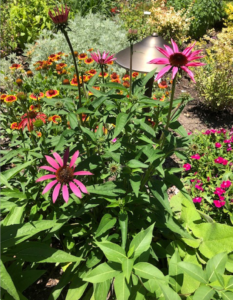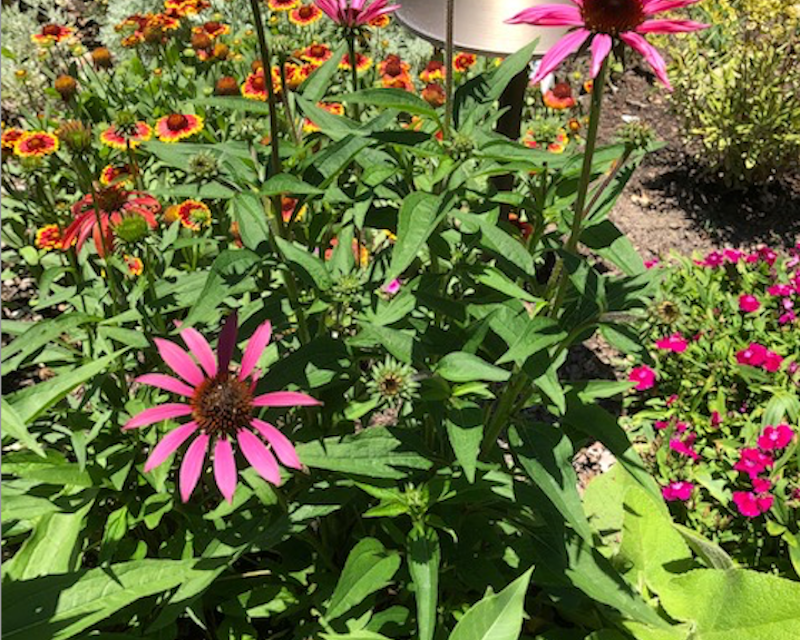
Coneflowers
This may seem very strange, but the hottest things in the horticultural world right now are American prairie plants. You know – those wildflowers and grasses waving in the wind in every western movie you have seen. I participate in many zoom meetings with horticulturists around the world and I have learned that prairie plants are used in Japan, Germany, the Netherlands, England, and many other places world-wide. It took me a long time to figure out why.
Most of the indigenous flowers in Europe and other areas of the world have their bloom time in the spring and early summer. By August, gardens are looking rather shopworn. Our native plants tend to bloom later. Yes, we do have spring blooming wildflowers, but many plants in colder areas like the northern Midwest tend to do their “thing” later. This desire to have late blooming plants and autumn color goes way back in time, especially for the British Isles.
In the eighteenth century, a Quaker in Philadelphia named John Bartram made quite a bit of money shipping over North American plants in what became known as “Bartram Boxes.” He had another Quaker businessman at the other end receive his shipments and sell them to wealthy landowners who wanted their own “American Garden” on their lavish estates. I read that the two most popular items sent to England were Liquidambar styraciflua and something known as Rhus. Imagine my surprise when I found out that they were Sweetgum and Sumac. I hate Sweetgum with all those seed heads that look like the Corona virus! They are all over one area of my garden and I am forever pulling out baby Sweetgum trees. Why would these two plants be in such great demand? Fall color! The foremost tree in Britain is the Oak and we all know that they are pretty drab when their leaves turn. Even their beloved Linden trees, which they call Limes, are not noted for fall foliage.
The desire for some color and interest at the end of the summer and into the fall is what has driven gardeners outside of the United States to covet our trees, shrubs, and prairie plants.
What prairie plants are popular? Coneflowers (Echinacea purpurea) are a particular favorite. I have them in my garden. They are a short-lived perennial, but they do re-seed vigorously. There are many new cultivars coming out in different colors. I prefer the open petal varieties because most pollinators always like flowers with open blossoms that make it easier for them to get to the pollen. Coneflowers are longer lived in colder climates and there are all sorts of plant trials going on right now to see which varieties live the longest and how plant breeders can produce longer lived cultivars.
Another favorite is something we see along the sides of the road every autumn- Goldenrod (solidago) It certainly does seem strange that gardeners would pay for something that we take for granted. Most of our native goldenrod is Solidago canadensis or Canada goldenrod. It is very tall and flops over. I do have Goldenrod in the back of my garden, but I have to stake it. Growers have come up with smaller varieties and even a dwarf goldenrod. Bees love it. It is an aggressive re-seeder so watch it or keep it contained.
A fall bloomer that seems to grow many places in the United States is aster. Asters are a huge family, in fact, they are their own genus. Members of the aster family are found all over the world. Our most common aster is the New England aster (Symphyotrichum novae-angliae). It grows about 3-4 feet tall and although most sources say that it is hardy in zones 4-8, it seems to thrive down here. It can get leggy so it is a plant that can benefit from what is known as the “Chelsea Chop.” This is cutting the plant down by half to force it to grow side shoots. It is called by that name because it is done in Britain around the time of the Chelsea Flower Show held the third week in May.
And do not forget native grasses for fall and winter interest. Northern Sea Oats (Chasmanthium latifolium) grows in the wild here. It is also one of the few grasses that will take some shade. The seeds look like little fish on a string.
We are so fortunate that in the Lowcountry we have something blooming nearly every day of the year. Enjoy those late summer and fall bloomers!









